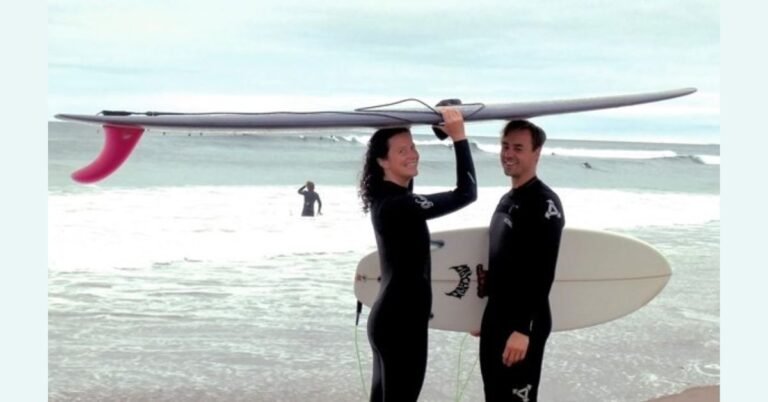Surfing is often seen as a solitary sport, where individuals test their skills against the waves, feeling the rush of adrenaline as they ride the surf alone. But, what if the thrill could be doubled? Surfing with a partner is an exciting, dynamic way to experience the ocean together, and it brings a whole new level of fun and challenge to your surf sessions. Whether you’re sharing waves, tackling challenges, or simply enjoying the rhythm of the ocean with someone special, surfing with a partner is an adventure that offers both physical and emotional rewards.
This comprehensive guide dives into everything you need to know about surfing with a partner, from safety tips and techniques to the benefits and challenges of sharing waves. We’ll also take a look at how to improve your surfing partnership, so you can enjoy those waves together while making unforgettable memories.
The Benefits of Surfing with a Partner
Surfing with a partner offers numerous advantages that go beyond the thrill of shared experience. Here’s a breakdown of the benefits:
1. Enhanced Safety
The ocean can be unpredictable. Having a partner by your side can significantly enhance your safety. They can watch your back, help you in case you wipe out, and provide a supportive presence if you’re struggling with the surf conditions. Partners can also help with spotting rip currents and advising on when to paddle out or call it a day.
2. Motivation and Encouragement
There’s no better motivation than seeing your partner catch a perfect wave or cheering them on from the shore. Surfing together fosters an encouraging environment, where both partners feel supported. Whether you’re sharing a wave or practicing new tricks, having someone to celebrate your successes with or help you overcome your failures makes the experience all the more rewarding.
3. Faster Learning Curve
If you’re new to surfing or learning advanced maneuvers, having a partner can accelerate your progress. Partners can offer tips, share insights on body positioning, or even help you practice balance. They can also spot mistakes you may not notice and provide immediate feedback, which is incredibly helpful in improving your technique.
4. Emotional Bonding
Surfing with a partner strengthens emotional connections. The shared experience of being in the water, facing challenges, and celebrating accomplishments together creates lasting memories and can bring you closer as a team. Whether you’re romantic partners, friends, or family members, surfing together fosters a unique bond that is hard to replicate in other activities.
5. Fun and Playfulness
Surfing with a partner adds an element of playfulness and fun. From trying out tandem surfing to simply enjoying the shared energy in the water, the experience becomes lighter and more enjoyable. It’s also an excellent way to create new challenges and try things you wouldn’t do alone, like surfing synchronized or riding waves together.
Surfing Techniques for Partners
1. Tandem Surfing
Tandem surfing is an advanced technique where two surfers (typically a larger and smaller surfer) ride the same wave together, performing intricate moves like lifts and acrobatics. This form of surfing requires strong communication and perfect timing, as both surfers must coordinate their paddling, wave selection, and wave entry. The larger surfer usually leads, while the smaller surfer follows or performs the acrobatic moves.
While tandem surfing is spectacular, it requires trust, practice, and skill. For beginners, it’s best to start with simpler techniques, such as catching the same wave simultaneously or riding side-by-side.
2. Surfing Side-by-Side
Surfing side-by-side with a partner is a more accessible technique, especially for beginners. Both surfers paddle out at the same time, wait for the wave together, and catch it simultaneously. This allows both surfers to enjoy the ride and experience the wave together. It’s also an excellent way to practice synchronization, balance, and wave etiquette.
3. Paddle in Sync
Paddling in sync is one of the most important aspects of surfing with a partner. If you both paddle together at the right time, you’ll increase your chances of catching the wave. Synchronizing your paddling motions will also help conserve energy and maintain a smooth rhythm.
To practice this, try paddling together on smaller waves. It will help you understand timing and wave patterns, making it easier to ride larger waves with your partner.
4. Spotting Each Other
When surfing with a partner, especially for beginners, spotting each other is essential. One surfer can help guide the other, offering tips on when to paddle, how to angle your board, and when to get ready for the ride. After a wipeout, you can also be the first to lend a hand and make sure your partner is safe.
Communication and Synchronization in Surfing
Good communication is key to successful surfing with a partner. It’s not just about talking on land but also about reading each other’s body language and instincts while in the water. Here are some tips for effective communication:
- Hand Signals: Use hand signals to indicate where you want to go or to let your partner know when to start paddling. This helps avoid confusion, especially in a crowded lineup.
- Verbal Cues: Before hitting the water, decide on some verbal cues that both surfers can use to communicate during a surf session. Whether it’s for wave selection or troubleshooting an issue in technique, clear verbal cues can be a game-changer.
- Non-Verbal Cues: Sometimes, body language speaks louder than words. Learn to read your partner’s body language to understand when they’re ready to catch a wave or need assistance.
Common Challenges When Surfing with a Partner
While surfing with a partner can be incredibly rewarding, it also comes with its own set of challenges. These challenges are not insurmountable but require patience, practice, and teamwork to overcome.
1. Different Skill Levels
One of the most common challenges in surfing with a partner is having different skill levels. One surfer might be more experienced than the other, which can lead to frustration. The more experienced surfer should be patient and encourage their partner to progress at their own pace. It’s also helpful to practice together on waves that suit both skill levels, starting with smaller, more manageable waves.
2. Wave Etiquette
In surf culture, wave etiquette is crucial. When surfing with a partner, you need to be mindful of each other’s space and take turns catching waves. If both surfers attempt to catch the same wave at the same time, it can lead to accidents and missed opportunities. It’s essential to communicate openly about who will catch a wave and when.
3. Timing Issues
Synchronizing timing can be tricky, especially for beginners. One partner might be paddling too early, too late, or at the wrong angle. Regular practice, clear communication, and a bit of trial and error will help both surfers work out the timing and rhythm needed for success.
4. Different Fitness Levels
Surfers need a lot of physical endurance, and if you’re surfing with a partner who has a different level of fitness, it may affect your ability to maintain the same rhythm and energy. Make sure both surfers are comfortable with the level of physical activity required, and take breaks if needed to avoid exhaustion or injury.
How to Improve Your Surfing Partnership
To make the most out of your surfing with a partner, try the following strategies:
Start on Smaller Waves
If you’re a beginner or have a partner with less experience, start with smaller, mellow waves. This helps build confidence and makes it easier to synchronize movements.
Practice Together Regularly
Like any sport, the more you practice together, the better you will become. Set aside time to surf together regularly to improve your coordination, timing, and technique.
Celebrate Each Other’s Progress
Whether you’re both advancing or just having fun, make sure to celebrate each other’s progress. This fosters a positive, encouraging environment that helps both surfers thrive.
Respect Each Other’s Space
When sharing the waves, make sure to respect each other’s space. If one partner is catching a wave, the other should be ready to assist or wait for their turn.
Comparison Chart: Solo Surfing vs. Surfing with a Partner
| Aspect | Solo Surfing | Surfing with a Partner |
|---|---|---|
| Safety | Risk of being alone in the water | Enhanced safety, especially during wipeouts |
| Learning Curve | Self-reliant, can take longer | Faster learning due to shared knowledge |
| Motivation | Personal drive | Mutual support and encouragement |
| Wave Catching | Focused on personal waves | Shared waves, synchronized timing |
| Fun Factor | Individual experience | Double the fun, shared joy |
Conclusion
Surfing with a partner isn’t just about catching waves together; it’s about building a relationship, enhancing safety, and having a blast while doing something you love. Whether you’re tandem surfing, riding side-by-side, or simply paddling out together, the experience will bond you and your partner in ways that other activities can’t.
So, grab your board, invite a partner, and head to the surf! The waves are waiting, and with your partner by your side, there’s no limit to the fun and rewards you’ll experience.

